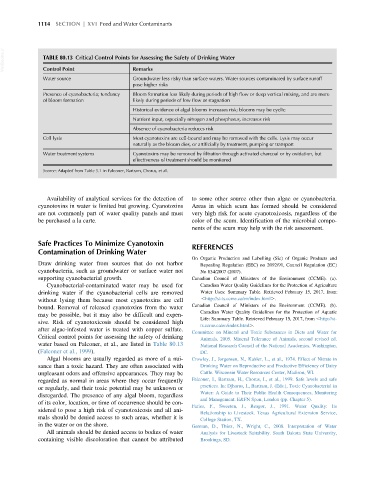Page 1182 - Veterinary Toxicology, Basic and Clinical Principles, 3rd Edition
P. 1182
1114 SECTION | XVI Feed and Water Contaminants
VetBooks.ir TABLE 80.13 Critical Control Points for Assessing the Safety of Drinking Water
Control Point
Remarks
Water source Groundwater less risky than surface waters. Water sources contaminated by surface runoff
pose higher risks
Presence of cyanobacteria; tendency Bloom formation less likely during periods of high flow or deep vertical mixing, and are more
of bloom formation likely during periods of low flow or stagnation
Historical evidence of algal blooms increases risk; blooms may be cyclic
Nutrient input, especially nitrogen and phosphorus, increases risk
Absence of cyanobacteria reduces risk
Cell lysis Most cyanotoxins are cell-bound and may be removed with the cells. Lysis may occur
naturally as the bloom dies, or artificially by treatment, pumping or transport
Water treatment systems Cyanotoxins may be removed by filtration through activated charcoal or by oxidation, but
effectiveness of treatment should be monitored
Source: Adapted from Table 5.1 in Falconer, Bartram, Chorus, et al.
Availability of analytical services for the detection of to some other source other than algae or cyanobacteria.
cyanotoxins in water is limited but growing. Cyanotoxins Areas in which scum has formed should be considered
are not commonly part of water quality panels and must very high risk for acute cyanotoxicosis, regardless of the
be purchased a la carte. color of the scum. Identification of the microbial compo-
nents of the scum may help with the risk assessment.
Safe Practices To Minimize Cyanotoxin REFERENCES
Contamination of Drinking Water
On Organic Production and Labelling (Sic) of Organic Products and
Draw drinking water from sources that do not harbor Repealing Regulation (EEC) no 2092/91, Council Regulation (EC)
cyanobacteria, such as groundwater or surface water not No 834/2007 (2007).
supporting cyanobacterial growth. Canadian Council of Ministers of the Environment (CCME). (a).
Cyanobacterial-contaminated water may be used for Canadian Water Quality Guidelines for the Protection of Agriculture
drinking water if the cyanobacterial cells are removed Water Uses: Summary Table. Retrieved February 15, 2017, from:
without lysing them because most cyanotoxins are cell ,http://st-ts.ccme.ca/en/index.html..
Canadian Council of Ministers of the Environment (CCME). (b).
bound. Removal of released cyanotoxins from the water
Canadian Water Quality Guidelines for the Protection of Aquatic
may be possible, but it may also be difficult and expen-
Life: Summary Table. Retrieved February 15, 2017, from ,http://st-
sive. Risk of cyanotoxicosis should be considered high
ts.ccme.ca/en/index.html..
after algae-infested water is treated with copper sulfate.
Committee on Mineral and Toxic Substances in Diets and Water for
Critical control points for assessing the safety of drinking
Animals, 2005. Mineral Tolerance of Animals, second revised ed.
water based on Falconer, et al., are listed in Table 80.13 National Research Council of the National Academies, Washington,
(Falconer et al., 1999). DC.
Algal blooms are usually regarded as more of a nui- Crowley, J., Jorgensen, N., Kahler, L., et al., 1974. Effect of Nitrate in
sance than a toxic hazard. They are often associated with Drinking Water on Reproductive and Productive Efficiency of Dairy
unpleasant odors and offensive appearances. They may be Cattle. Wisconsin Water Resources Center, Madison, WI.
regarded as normal in areas where they occur frequently Falconer, I., Bartram, H., Chorus, I., et al., 1999. Safe levels and safe
or regularly, and their toxic potential may be unknown or practices. In: Djhorus, I., Bartram, J. (Eds.), Toxic Cyanobacterial in
Water: A Guide to Their Public Health Consequences, Monitoring
disregarded. The presence of any algal bloom, regardless
and Management. E&FN Spon, London (pp. Chapter 5).
of its color, location, or time of occurrence should be con-
Faries, F., Sweeten, J., Reagor, J., 1991. Water Quality: Its
sidered to pose a high risk of cyanotoxicosis and all ani-
Relationship to Livestock. Texas Agricultural Extension Service,
mals should be denied access to such areas, whether it is College Station, TX.
in the water or on the shore. German, D., Thiex, N., Wright, C., 2008. Interpretation of Water
All animals should be denied access to bodies of water Analysis for Livestock Suitability. South Dakota State University,
containing visible discoloration that cannot be attributed Brookings, SD.

